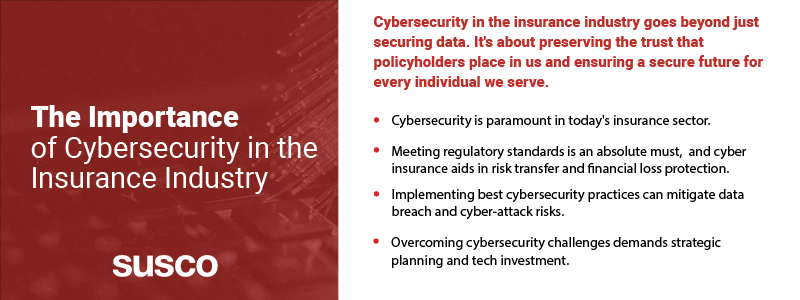Cybersecurity in the insurance industry goes beyond just securing data. It’s about preserving the trust that policyholders place in us and ensuring a secure future for every individual we serve.

Data has become the new gold in this digital era, and it draws its fair share of shady characters. The insurance industry has vast repositories of sensitive customer data, making it particularly vulnerable to these threats. Cybersecurity is thus not just an operational concern but a critical business imperative.
This guide explores the intricate world of cybersecurity in the insurance industry, including risks from data breaches to hacking and phishing attacks as well as best practices to keep these threats at bay. Whether you’re an insurance adjusting firm handling more than 10,000 claims annually or a small agency that’s just getting started, this post will equip you with the knowledge to safeguard your data and protect your future.
Cybersecurity risks in the insurance industry
The insurance industry’s treasure trove of sensitive data is like a magnet for cybercriminals. Personal identification, financial, and health records make insurance companies a veritable goldmine for hackers. Here are a few quick facts:
- The cybersecurity threats the industry grapples with are as diverse as sophisticated, with data breaches, hacking, and phishing attacks just the tip of the iceberg.
- Data breaches can expose sensitive customer information, leading to identity theft and financial fraud.
- Hacking attempts can cause financial losses and tarnish a company’s hard-earned reputation.
- Phishing attacks often target employees to gain unauthorized access to internal systems and data.
These attacks exploit human vulnerabilities, making them particularly difficult to prevent, and their impact is far-reaching. Customers may suffer financial losses and violations of privacy, leading to a loss of trust in the company. This loss of confidence can have long-term effects on the company’s customer relationships and market position. Employees may become victims of identity theft or be held liable for compliance violations.
The company itself can also face legal repercussions, financial losses, and damage to its reputation.
Regulatory requirements and compliance
In the face of these threats, regulatory compliance is about safeguarding sensitive information and maintaining customer trust – not just about ticking boxes. Insurance companies navigate a sea of regulations and must stick to the straight and narrow path of stringent compliance standards.
These rules are designed to shield sensitive data and make certain that companies have the right defenses to fend off data breaches and cyberattacks. They cover various aspects of data security, from sensitive data encryption to regular security practice auditing to ensure a swift and effective response when attacks occur.
Non-compliance can result in hefty fines, legal repercussions, and company reputation damage. In severe cases, it can even lead to the revocation of the company’s license to operate. This means regulatory compliance is not optional, but a necessity.
Best practices for cybersecurity in the insurance industry
Implementing best practices for cybersecurity is crucial in mitigating risks. These include:
- Regular employee training
- Network security measures, such as firewalls and intrusion detection systems
- Access control
- Continuous monitoring
- Regular risk assessment
Employee training is vital, as employees are often the weakest link in the security chain. It should cover the basics of cybersecurity, such as recognizing phishing attempts, using strong passwords, and following proper procedures for handling sensitive data, plus cover the latest threats and how to respond to a breach.
Network security measures help prevent unauthorized access to the company’s plans, and must be regularly updated and tested to ensure they can withstand the latest threats. Access control ensures only authorized individuals have access to sensitive data, while continuous monitoring and risk assessment help identify potential threats and vulnerabilities before they can be exploited.
Cyber insurance and risk transfer
Cyber insurance is another practical tool for transferring risk and protecting against potential financial losses from cyberattacks. It’s essential to understand its benefits and limitations, however:
- Cyber insurance can cover the financial losses from a cyber attack, including data recovery costs, legal fees, and customer notification.
- It cannot prevent a cyber attack from happening in the first place, nor can it repair the damage to the company’s reputation.
- This is why cyber insurance should be part of a comprehensive cybersecurity strategy rather than a replacement for one.
Many companies wrongly assume that having backups in the cloud can prevent or reduce the impacts of a ransomware attack. This is only sometimes the case, however, and insurers often require proof of secure backup implementation for policy coverage.
Take control of your cybersecurity with Susco
Insurance companies face several challenges in implementing effective cybersecurity measures, including resource constraints and the rapidly evolving threat landscape, but partnering with cybersecurity experts and investing in advanced technology solutions can help.
Cybersecurity is a continuous process that requires strategic planning, investment, and vigilance. As the insurance industry navigates the digital landscape, staying ahead of cybersecurity trends and innovations is crucial for success.
But you don’t have to do it alone. Susco is here to provide expert advice, resources, and guidance. We’re committed to helping you safeguard your data and future. Don’t leave your cybersecurity to chance – reach out today and take control of your cybersecurity journey.